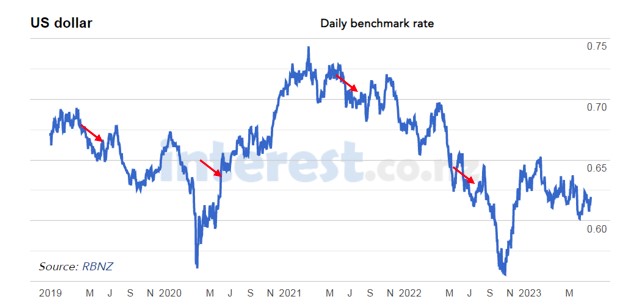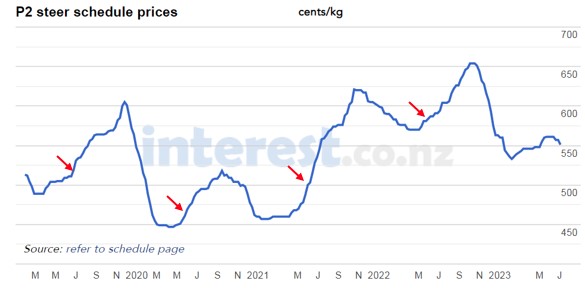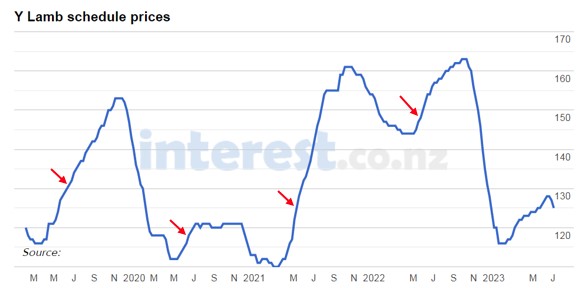
Earlier this year Beef+LambNZ reported that farmers were facing inflation two and half times higher than the consumer price index (CPI). Largely driven by interest rates, fertiliser and fuel there is no sign that these costs will reduce anytime soon.
This has occurred at the same time that product for milk and meat products have been decreasing.
Helping to ease the stress of the rising costs and falling returns farmers have been fed a diet of 'expert' opinion that returns will improve shortly as the Chinese economy gets into gear and influences returns. So, here we are into the second half of the year and prices are still falling.
For beef and sheep farmers we should normally now be well into the period when prices being paid by processors are climbing to normally peak around September due to supply constraints. This year with the New Zealand dollar hardly setting the world alight, the exchange rate can not be blamed for the poor returns farmers are currently seeing.
The red arrows point to the same period in the last four years. In fact, the low dollar can be blamed for some of the higher costs’ farmers face and most years there is a balancing effect with the lower dollar helping to push up farm gate returns. This effect can be seen to some degree in the graphs below. But not this year.

At the moment the P2 (prime) schedule for steer is bucking the trend as shown on the graph below. The red arrows show where the schedule was at comparable times over the last four years and this was right through the Covid years.

The Lamb schedule shows a similar pattern, although 2020 had the decency to recognise that a pandemic was on. It is perhaps worth mentioning that through most of the graph’s periods China was in various forms of lock-downs and the distribution of product was difficult. Making this years results even more troubling.

So, what is happening now?
When it comes to beef, one of the supply factors that has been depressed recently (due to food safety issues) was Brazil. The world’s largest producer, Brazil's exports of beef have now retaken volumes from before the pandemic. Compared to June 2022, there was a -0.9% decrease in the average daily value of beef exports from Brazil. However, there was a 33.1% gain in the average daily quantity exported, and a 25.6% devaluation in the average price. (The data were released by Brazil's Foreign Trade Secretariat).
A significant factor for their lift has been China's announcement that it will be lifting the ban on all Brazilian beef produced from February 22 (2023), following the detection of an atypical case of mad cow disease in a nine-year-old animal on a rural property in Pará.
China is also reported as having a more friendly view of Brazil under now President Lula as opposed to previous president Bolsonaro who was said to hold an “Undiplomatic” stance towards China.
Alliance meats is also reported as negotiating with one of its major China opportunities to further spread the reach into China of its beef products. This shows the importance China will have in the future although it goes against Alliance's own comments of “redirecting as much product as possible away from China”.
New Zealand farmers are not the only ones hurting with an Irish press article saying “Unfortunately, from an Irish viewpoint, the prices being paid in China are much lower than they were in recent years. No doubt driven by increased supplies from Argentina, Australia, Brazil and the US. Along with New Zealand and Uruguay these countries account for 98% of Chinese beef imports in 2022”.
For lamb and mutton, the lack of China and also the reported added amounts of Australian sheep meats “circulating in key markets for New Zealand for this time of year” are combining to put a damper on farmgate returns.
Again, the question; what is different to previous years come to mind, given how strongly the seasonal supply has impacted on price in the past. If the lamb price in particular does not start to pick up soon, some lamb finishes will be hurting having brought in stock in April and May working on the premise that prices will improve as the winter progresses. Sadly, to date the reverse has occurred.
Dairy farmers also are not immune to the lack of upsides on world markets with the latest Global dairy auction falling another -3.3%.
- Butter index down 10.3%, average price US$4,842/MT
- Cheddar index down 3.1%, average price US$4,386/MT
- SMP index down 6.0%, average price US$2,525/MT
- WMP index down 0.4%, average price US$3,149/MT
Butter and to a lesser extent Cheddar have both lost all the gains they made through May. While the powders have continued their reductions that started in early May. The best that can be said is Whole Milk Powder (WMP) has had the least falls and pretty much flat lining at the moment.
Again, the lack of the expected upturn in China is the main driver although Cheese and Butter may be reflecting global conditions impacting.
The only positive is; if prices are going to fall now is perhaps a better time than any other time of year with less product (be it milk or meat) moving at this time of year. However, this is cold comfort to those who are still trading now and it’s not a great omen for the remaining part of the year.
One last thing to show that it’s not only food products that are falling. The price of carbon has had a considerable collapse.

Source: Jarden Securities
The low price has not stopped several overseas firms buying up more New Zealand farmland with four properties being approved for sale by the OIO.
13 Comments
"Largely driven by interest rates, fertiliser and fuel there is no sign that these costs will reduce anytime soon"
Interest rates, probably over paid for the farm necessitating a large mortgage.
Fertilser would have been lower much sooner if there was no NZ govt 35% duty on Russian fertiliser, not with standing there are no US sanctions on Russian fertiliser. EU has blown hot and cold, maybe some EU countries of their own volition do not import Russian fertiliser at all or impose duties and others import freely. Too much in the messy basket to find out.
My mortgage rate just cracked 8.00% - ouch.
Sending cattle at .40c to .50c kg below budget - ouch.
Farm better suited for growing rice - ouch.
Only entertainment political shenanigans.
Meat works are businesses, taking advantage of weather conditions, backlog of cattle as farmers unload, no need to pay more.
Belle - I made one rash prediction about the direction of the beef schedule over winter a couple years ago - got it wrong..
All I know is that a couple months ago guys in the industry I respect were talking a spring peak of $7 with a gradual rise from $6 from mid June.
Now they are doom and gloom. the USA has caught them out with a lack of demand and China no better.
I think they are over selling the sadness to justify pulling down the schedule with so many cattle lined up waiting to get in.
The meat works appear much more business orientated since SFF shareholding sale.
I do not want to generalize but some attendance issues with staffing since Covid. A change in commitment to work ethic?
The trouble with Beef is their is just not enough profit in the whole chain, usually it’s the calf rearer who works for nothing, currently it’s finishers and certainly not processors who are making records profits currently.
Hard to see a prosperous future in it when you add on emission levy’s




We welcome your comments below. If you are not already registered, please register to comment.
Remember we welcome robust, respectful and insightful debate. We don't welcome abusive or defamatory comments and will de-register those repeatedly making such comments. Our current comment policy is here.